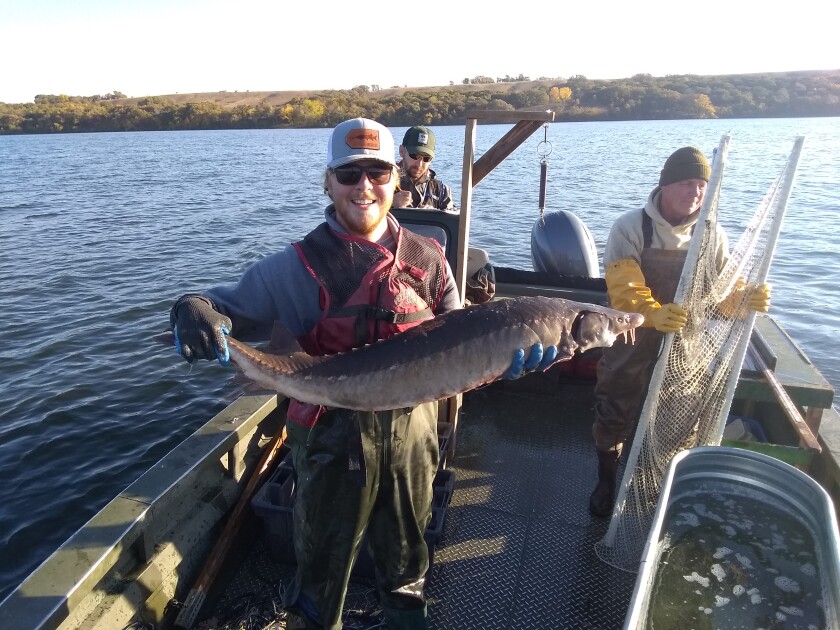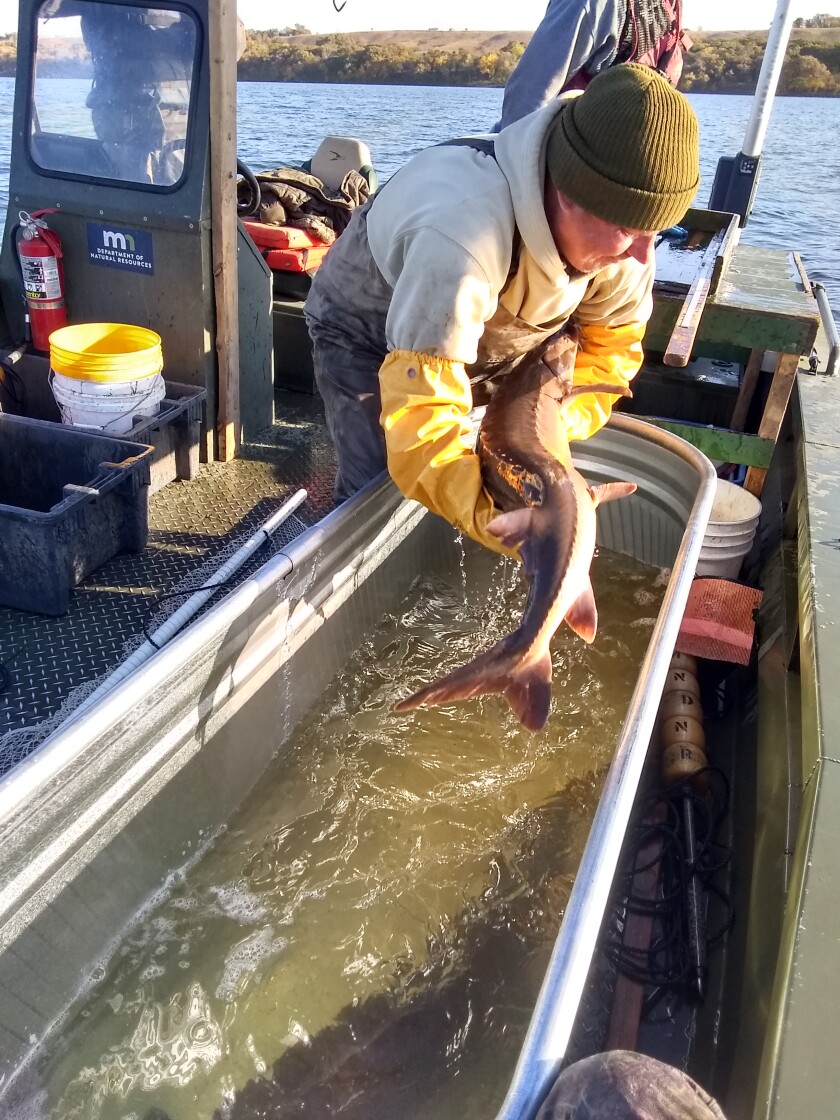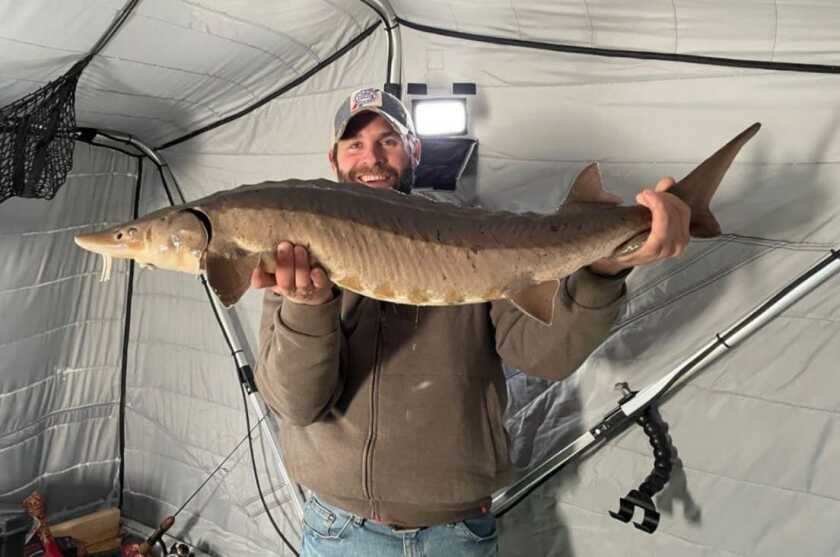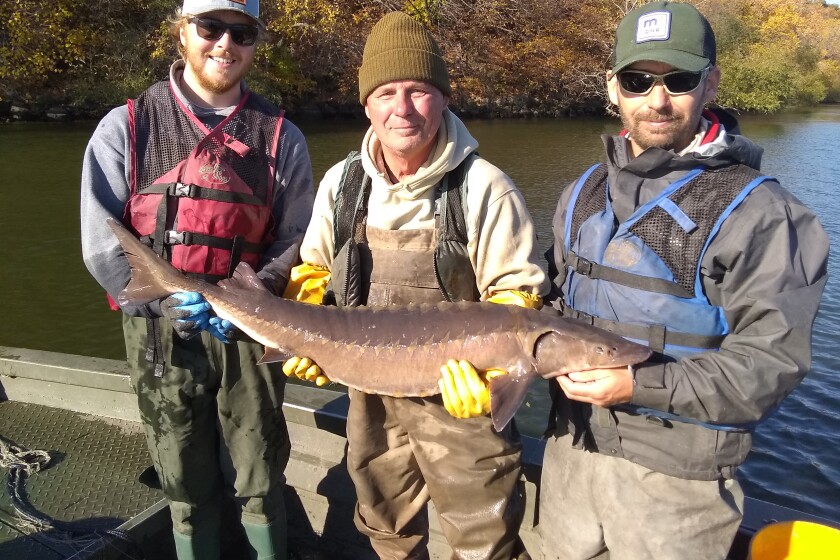ORTONVILLE, Minn. — A back-to-the future story is unfolding in a big way on Big Stone Lake and in the Upper Minnesota River watershed, where an eight-year-long process to restore lake sturgeon to these waters is showing promise.
Sturgeon up to 50 inches in length, several of them weighing 31 pounds, emerged from the waters of the lake when Department of Natural Resources fisheries staff pulled special gill nets they had set in October. The nets were set at four locations in the 26-mile long lake. The fish they caught showed good population numbers and growth rates for the fish, according to Chris Domeier, fisheries supervisor with the DNR in Ortonville.
Since 2014, the DNR has worked in partnership with the Wisconsin Department of Natural Resources, the U.S. Fish and Wildlife Service and the South Dakota Game, Fish and Parks to stock fingerling lake sturgeon in Big Stone Lake. They are the progeny of sturgeon from the Wisconsin River, part of the Mississippi River watershed as is Big Stone Lake.
Each year, an average of roughly 4,000 fingerlings are stocked in the lake.
Big Stone Lake once held a sturgeon population so large that they were commercially harvested. But over-harvest, the construction of dams on tributary waters that took away connectivity, degrading water quality, and a string of harsh winters are believed to be responsible for the disappearance of this prehistoric fish from Big Stone Lake. The last known sturgeon was found washed up on its shoreline in 1938.
ADVERTISEMENT
Now, Domeier and his staff periodically receive reports from anglers who happen to catch sturgeon. The reports of incidental catches also tell them the fish are increasingly mobile and making their way into adjoining waters. This autumn, the fisheries supervisor received reports of four large sturgeon caught by anglers just below the Lac qui Parle dam.
It’s not a surprise. Domeier said the riverine system fish are likely to take advantage of the feed and spawning habitat that tributary waters including the Minnesota, Pomme de Terre and Chippewa Rivers offer.
Former fisheries supervisor Norm Haukos, who has since retired, initially promoted the sturgeon reintroduction project. He believed that improving water quality in the lake, and efforts to restore connectivity to tributary waters, made it possible for this ancient fish to once again thrive in these waters.

The recent netting survey indicates that conditions are indeed favorable. Water clarity in the lake has been improving for more than a decade now, noted Domeier. In fact, the once turbid lake is changing in a big way. Aquatic vegetation now thrives in the once-turbid waters and the lake is transitioning from a world-class walleye lake to a world-class largemouth bass and bluegill lake, he said.
Most important for the sturgeon, the shallow lake has a mostly uniform, silty bottom that supports a large population of invertebrates such as midges and mayflies that are food for the sturgeon. Like whales that grow large on tiny krill in the ocean, sturgeon feed on large numbers of these invertebrates found on the lake bottom.

The hope is that these stocked sturgeon will establish a self-sustaining population once they reach sexual maturity. The rule of thumb is that female sturgeon reach sexual maturity after 20 years.
The growth rates exhibited by the fish in Big Stone Lake has Domeier and others in the fisheries staff hopeful that these fish may reach sexual maturity at a younger age. These sturgeon are at the southern edge of their natural range and there is not a lot known about southern range sturgeon, said Domeier.
A group of male sturgeon from Big Stone Lake were rescued last year after they had migrated upstream to a small water body near Milbank, South Dakota, and had become trapped. It’s not known if they had migrated based on the instinct to spawn, but it’s possible, he noted. The fish were rescued in the post-spawning period and there was no milt to indicate whether the fish were sexually mature.
ADVERTISEMENT

If this restoration succeeds, the day may come when a controlled harvest of sturgeon could be offered on Big Stone Lake, Domeier noted. There’s no doubt that the large fish will attract anglers. The Rainy River is famous for the anglers who come for a catch-and-release season that gives them the opportunity in the spring to tangle with the behemoth fish.

How big can they get? In February of 2019, Darren Troseth of Jordan, with help from friend John Kimble, caught and released what is believed to have been the biggest fish ever caught in Minnesota. Troseth caught a 78-inch lake sturgeon estimated to have weighed 120 pounds while ice fishing on the St. Croix River.












